Visiting El Pou Clar and the Moorish Caves of Bocairent, Spain
I love caves. I’ve found them fascinating ever since I was a little girl, and while I could never be considered an adventure traveller, there is something about exploring caves that makes me feel like quite the intrepid explorer.
Caves have somewhat of a mystical appeal to them, and I love that they will provide warmth, shelter, and even a place to hide to whoever happens to be in need.
I also love exploring the off-the-beaten-track spots around Valencia, the city where I live, and so when Daniel from local tour company Valtournative reached out and invited me on an excursion to the nearby town of Bocairent (or Bocairente in Spanish) to explore some ancient Moorish caves, followed by a visit to the clear pools of El Pou Clar, I almost bit his hand off.
I’d met with Daniel twice before, on excursions to the thermal springs of Montanejos, and also to the Utiel-Requena wine region, and so I knew that this tour would not disappoint.

Daniel’s aim with Valtournative is to get tourists away from the hustle and bustle of central Valencia and introduce them to some hidden gems that they would never otherwise find. With a strong focus on history, culture and gastronomy, all of their tours are right up my street, and this one was no different.
Read on to find out all about the Moorish Caves of Bocairent, its charming Old Town and the natural pools of nearby Pou Clar.
Visiting El Pou Clar & the Moorish Caves of Valencia
Bocairent Moorish Caves – A brief history
Bocairent is said by many to be one of the prettiest villages in Spain, and as we drew closer to this majestic village on a rock, I could immediately see why.
In fact, I had to pinch myself to double check that I wasn’t back in Matera, the Italian city famous for its cave dwellings and sweeping panoramas that captured my heart back in 2019.
Although archaeological finds around Bocairent show human settlements dating back to Palaeolithic times, it is the Islamic period that has shaped the town we see today.
The Moors (Muslims) arrived in Spain from North Africa and ruled parts of the Iberian Peninsula from 711 AD until the fall of Granada in 1492 – that’s 700 years of Arab rule, and Bocairent is just one of many places in Spain where we can still see their rich legacy reflected almost everywhere we turn.
In fact, Bocairent actually takes its name from the Arabic word bakirén or bekirent, which translates to ‘pineapple’ or ‘hive.’ This refers to the way that the whole Old Town is higgledy-piggledy, with the buildings seeming like they are almost stacked on top of one another, all surrounding the castle and sitting on a hill.
Just 300 metres away from the Old Town lie the Moorish Caves of Bocairent, or Les Covetes dels Moros if we’re giving them their proper name.
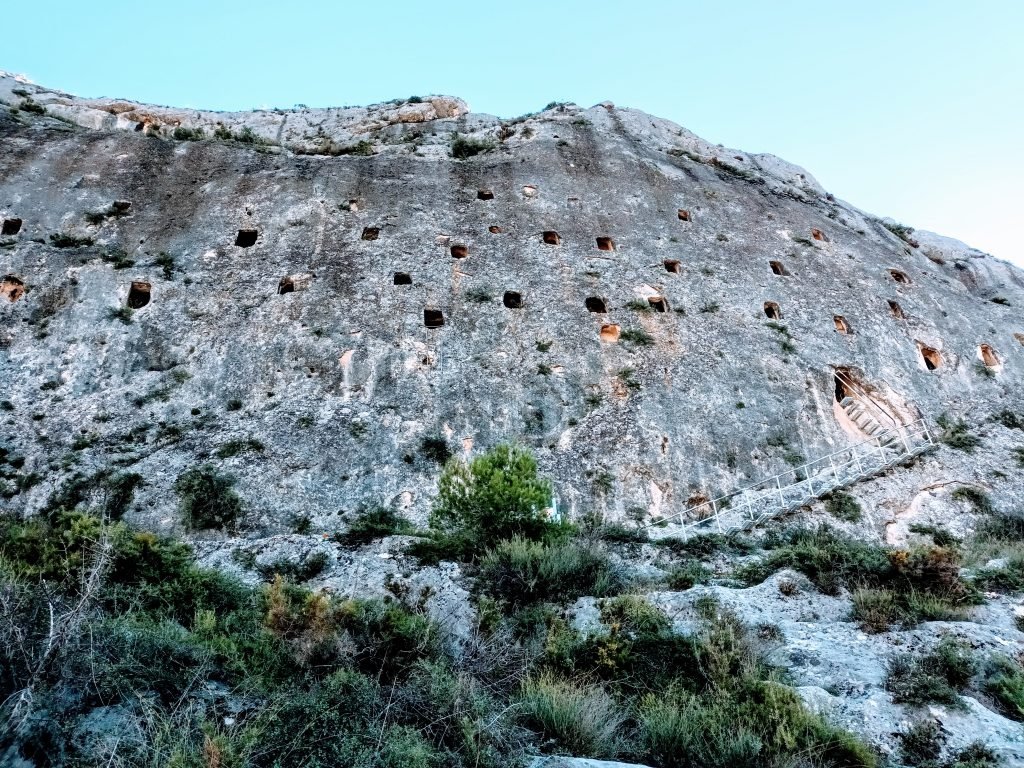
Carved into the side of the Fos Ravine, this group of man-made Bocairent caves took hundreds of years to construct (it is estimated that just one chamber took over 450 years to carve out!), and there are about 50 holes in the shape of windows looking out from the Ravine across to the Old Town, with a separate room behind each of these windows.
Originally, Bocairent caves were used as storage rooms for grains and other foods, but when the Christians tried to conquer the area, the Moorish people who lived in Bocairent would hide in them – getting up to the windows required expert knowledge of the rockface (not to mention solid climbing skills!) and so the Moors were able to take refuge here, safe from outside threats.
The windows also provided fantastic lookout points from which the Moors would be able to see the Christians, but the Christians wouldn’t be able to see them as easily.
In the 13th century, however, the Christians did manage to take over the town of Bocairent, and when they managed to scramble up the Ravine and enter the caves, they didn’t have a clue what to use them for!
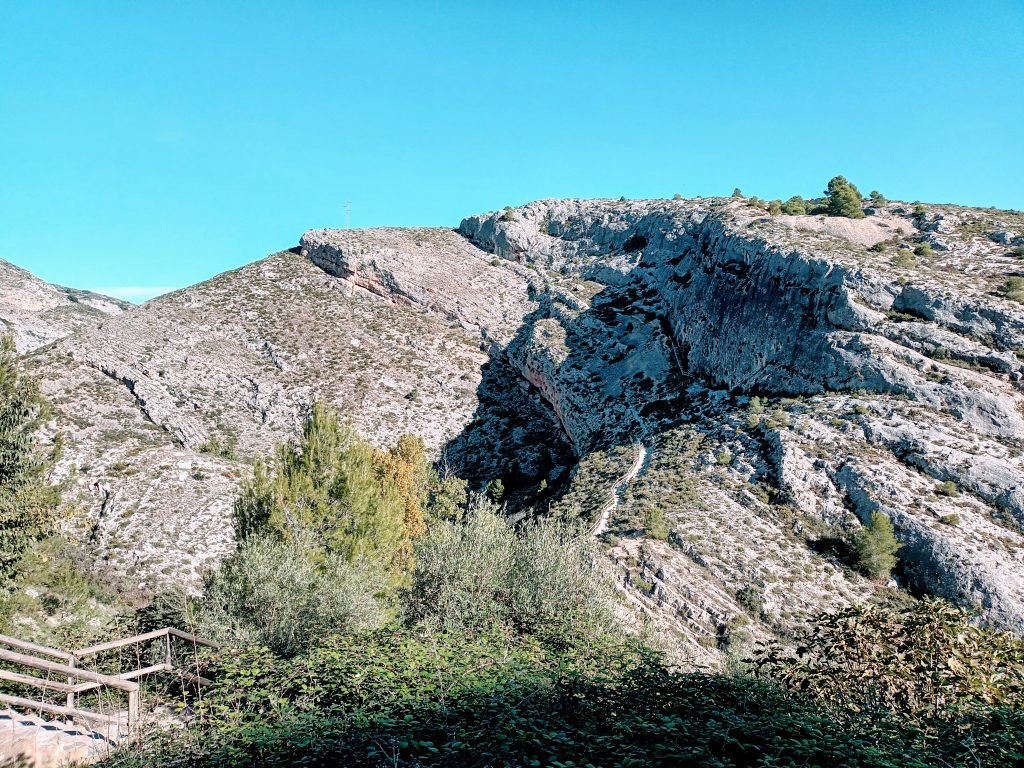
Caves such as these are only found in parts of North Africa such as Morocco and Tunisia, and so the Christians were stumped!
With the original purpose of Bocairent caves lost, the Christians knocked through the various chambers and created the warren-like network of rooms that we see today.
It is these rooms that I was about to explore for myself.

Exploring the Moorish Caves of Bocairent
Much to my delight, Daniel told us that we would be exploring about 20 of 50 rooms inside the Bocairent caves!
However, there was definitely a part of me that was nervous as he’d advised us to wear ‘climbing clothes’ such as joggers and trainers, and anybody who knows me will know that I am not the best (to put it mildly!) when it comes to anything physical!
To get into the caves themselves, we climbed up a set of aluminium stairs and came face to face with a hole in the wall that gave way to a steep incline, with a rope to hang onto.
Oh god, I thought. Good job I have health insurance.
However, it wasn’t actually that difficult to scramble up the slope to the first ‘room’ of the caves, where we sat as Daniel explained that the caves were carved entirely by hand, and you can still see the imprints of the tools they used to chisel away at the rock.


Our next challenge was to climb up through a hole in the ceiling using a ladder, which was more difficult than it looked as there was a small space to clear at the top, and the rock was super shiny and slippery!
Luckily, Daniel was there to pull me up!
The way to each room was slightly different. For some of the rooms, we could simply crawl through small passageways, while for others we had to scramble up through holes in the ceiling (or ‘chimney flues’) without the help of ladders (see picture below!).
My personal favourite was a kind of ‘slide,’ where we simply sat on our bums and slid down two levels on the smooth rock surface, emerging into yet another little grotto.


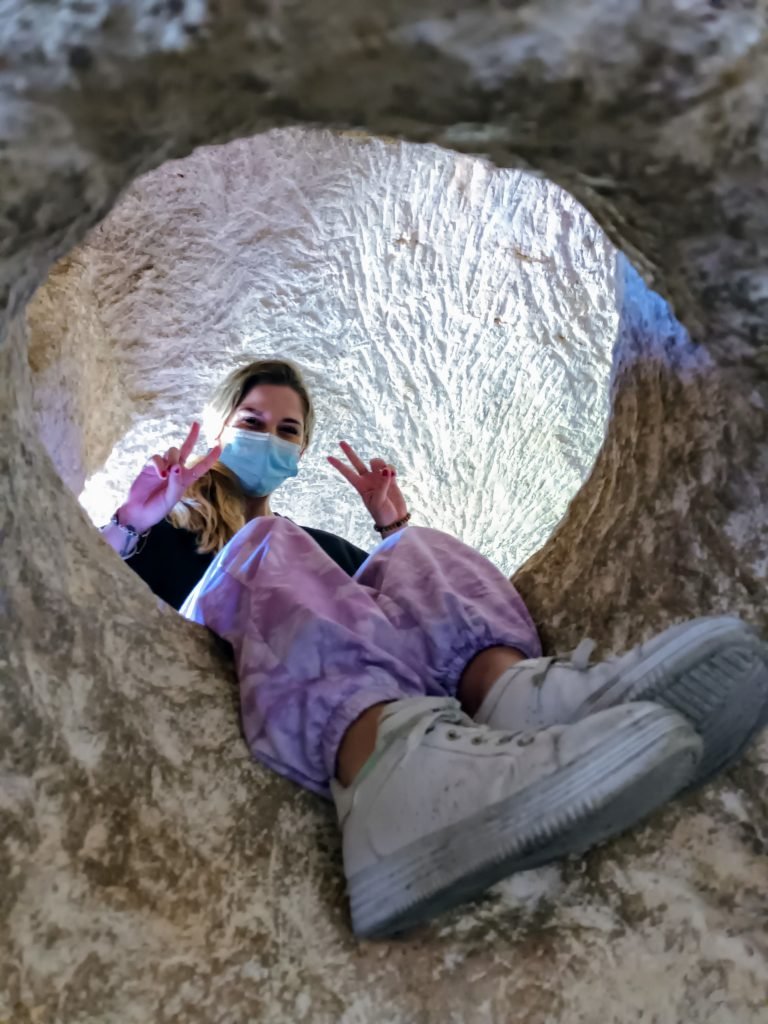
In every room, we stopped for a rest and listened while Daniel explained more about the history of Bocairent’s caves and Moorish people.
We admired the glorious sweeping views from the windows, and in one room we even discovered some shellfish fossils embedded into the floors, which showed that many many years ago, the caves were totally underwater.
Despite my hesitation at the beginning, I thoroughly enjoyed passing through the caves, and climbing through the holes and small spaces really wasn’t as tricky as I’d initially imagined!
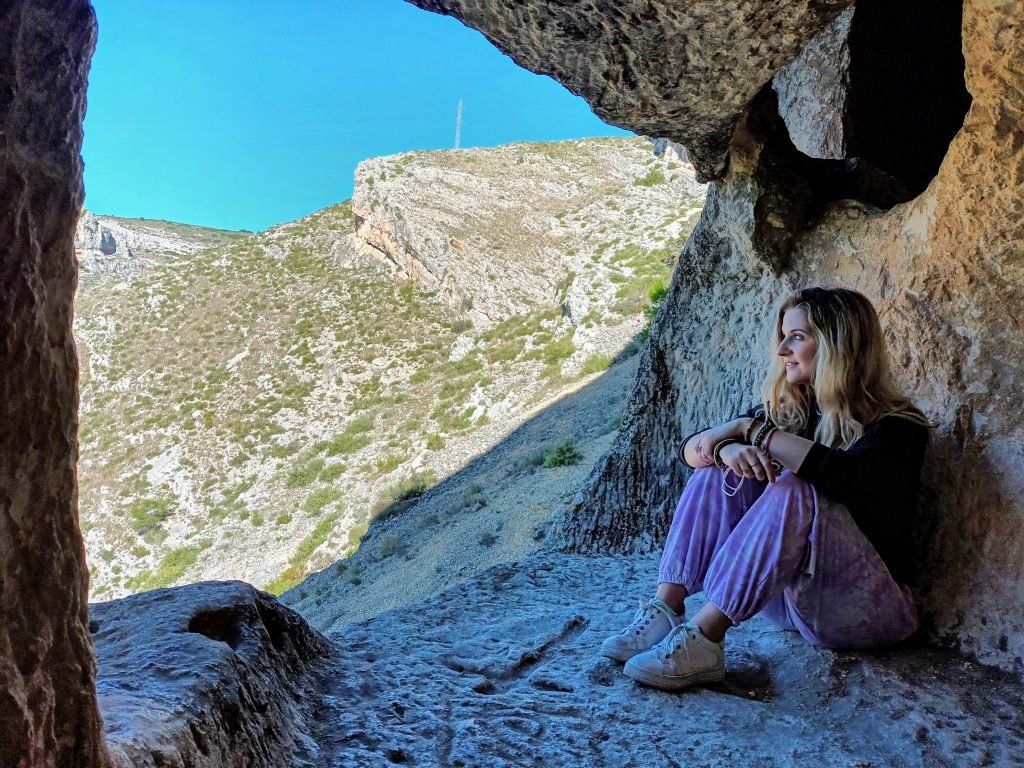
The medieval Old Town of Bocairent
When we emerged from the final cave room, we stopped for a moment to enjoy the bright sunshine and views before strolling back to town to begin our explorations of Bocairent itself.
The medieval quarter of Bocairent was declared a national historical and artistic site in 1975, and Daniel made sure to stop at notable points around the town and explain things about Bocairent and its history to us.
For example, on entering Bocairent, there is a very pretty winding street on the right which looks like it leads somewhere, but it is actually a dead end.
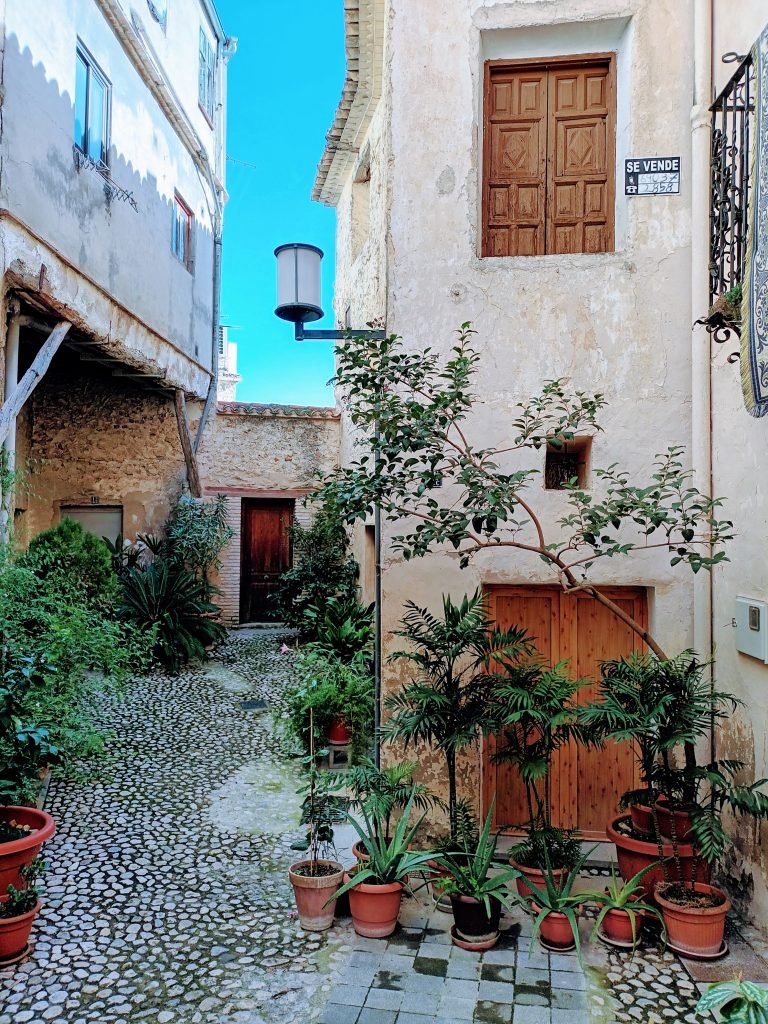
Daniel explained that this was typical of Arab towns, and that the purpose was to confuse intruders and get them lost in this labyrinthine network.
Another tell-tale sign that Bocairent was once an Arab town is the abundance of water fountains everywhere, from an aljibe, or cistern used for washing clothes, to fountains for drinking and hand washing.
Fountains have always been very important in Arab towns, not only to provide fresh drinking water for the townspeople, but also to assist with the ritual purification before prayer.


As we wandered, we stumbled on several more dead ends, winding staircases and narrow, uneven streets. The chaotic structure of Bocairent’s Old Town gives it an otherworldly, almost mythical feel, which was only heightened when Daniel told us that each house has its very own cave underground!




We eventually came to the remains of a medieval village house where the caves are still intact.
While the house itself is no more, it is possible to go into several ‘cave rooms,’ including the place where the animals would have been kept (animals kept the houses warm before central heating was invented!).
It was super interesting to be able to explore these caves right in the centre of the Old Town, and I genuinely felt like I’d stepped back to medieval times.



Our last stop in Bocairent was a tiny, medieval-style gourmet food shop, the Mercacentro Gourmet Medieval Store.
Owned by 4 siblings all dedicated to using local products to product artisanal food and drink at the best prices possible, stepping inside this store was like heaven for me.
All too often, slow food and artisanal products come with a price tag to match, but here, everything was beyond reasonable.
When I asked one of the brothers why everything was so cheap, he shrugged and said that they wanted to encourage people from Bocairent to buy local products, which I think is super admirable considering how much they could be charging for their goods!
We were then offered a tasting of a small selection of products, so of course we obliged!
Our host produced little tostadas with black olive tapenade, sweet cream cheese, and a codfish and sundried tomato paste – yum!
When we’d finished, we tried the homemade wine made with mountain herbs, a vermouth, and some rice liqueur, or arroz licor.
Other products on offer included truffle cheese, different spreads and jams, honey, sausage, artisan olive oils (I bought 4 different oils!), pate, quince and more.
I only wish I could do my weekly shop at this store – I loved it so much!
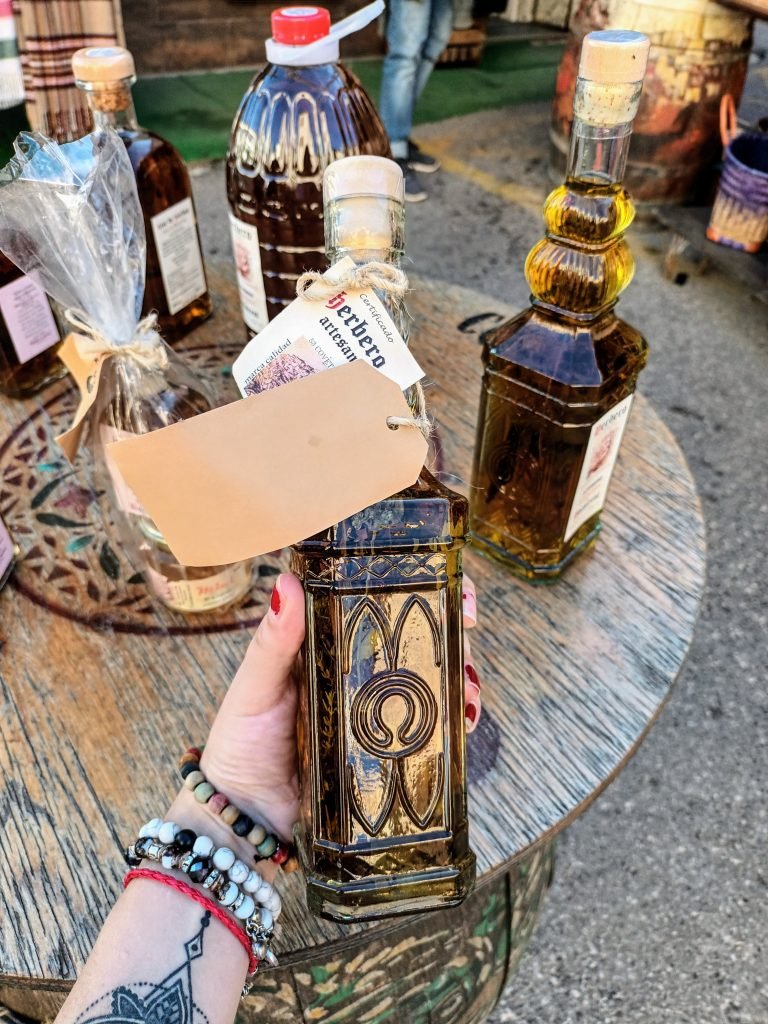
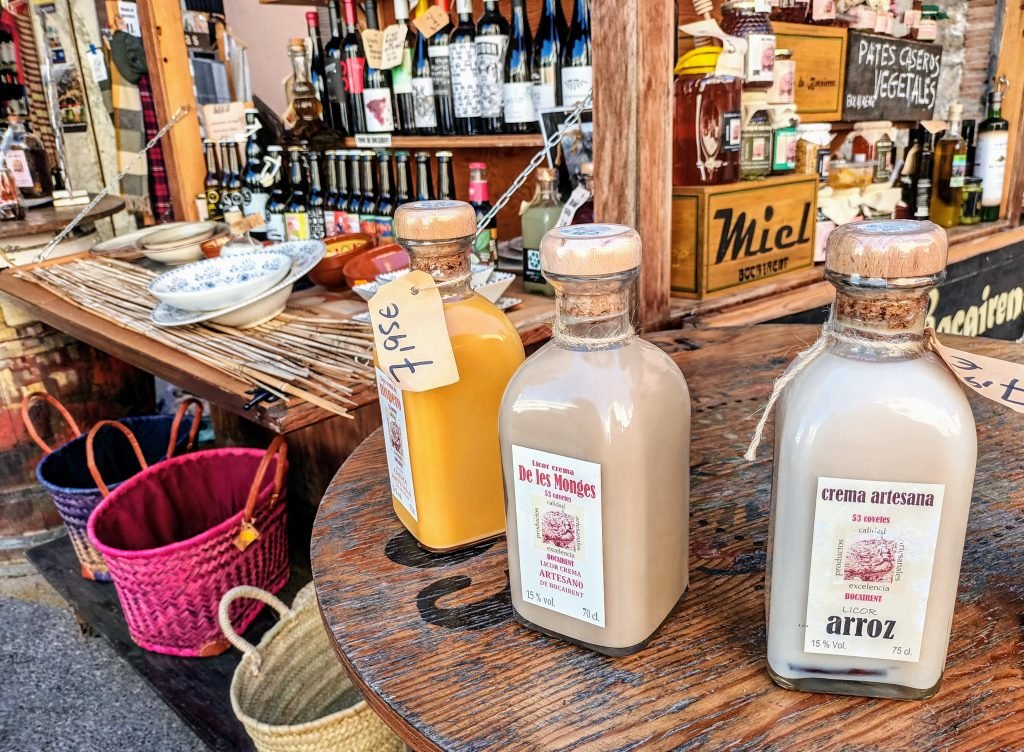
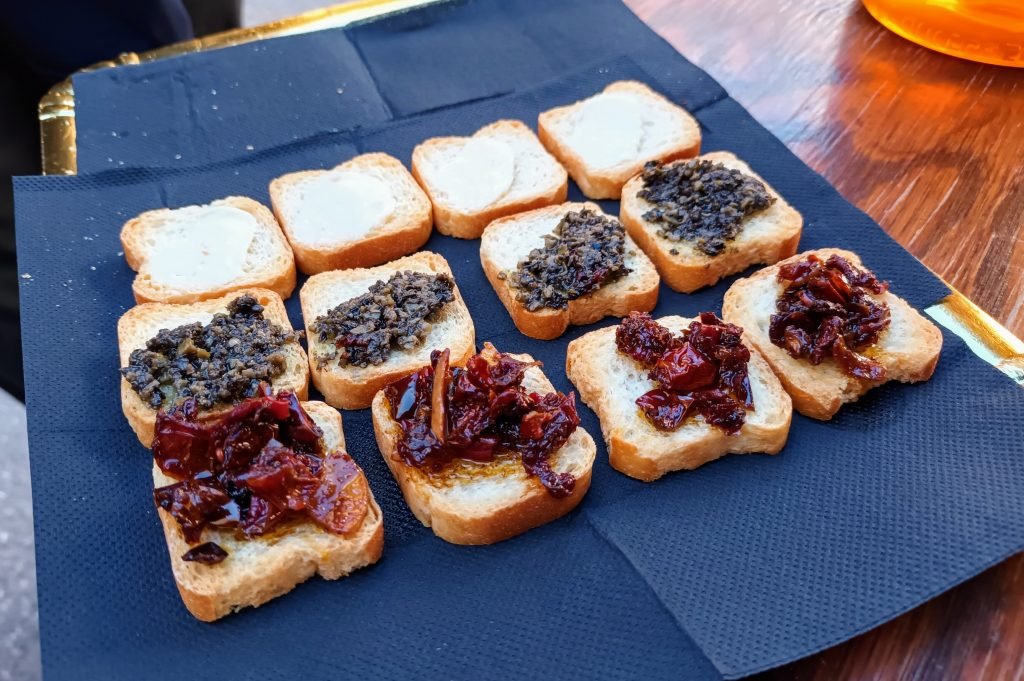

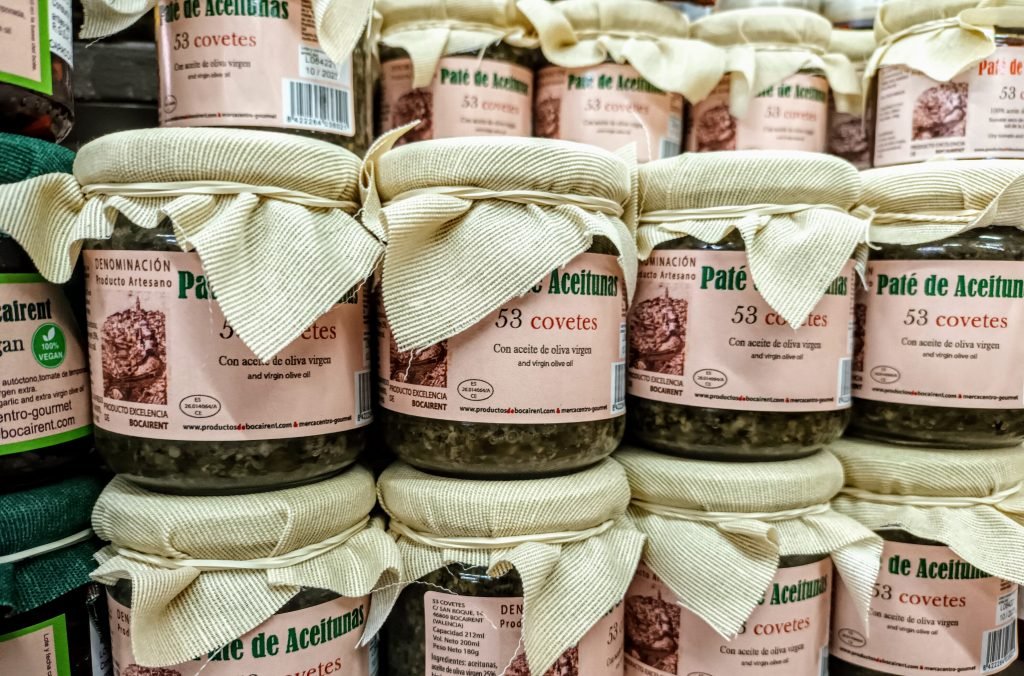

A typical Spanish lunch
After sampling all of that local liquor, we were definitely ready for some lunch, and so we were happy when Daniel said that the restaurant we were going to was only a short drive away.
La Porada restaurant is part of the L’Estacio Hotel and is famous for its fresh Mediterranean cuisine and stone-cooked meat.
In true Spanish fashion, we opted for the Menu del Dia, which is a 3-course set menu at a reduced rate from the A La Carte menu.
I opted for spinach cannelloni to start, followed by pork secreto (a superior cut of meat from the shoulder of the pig) with potatoes and garlic, and a sponge cake for dessert.
To be honest, the cannelloni didn’t win me over (it seemed as though it had been sitting around for a while), but the pork secreto was delicious and more than made up for it.
I’m not usually a pork lover, but I knew that this was a great cut of meat and so I took the plunge, and boy was I glad I did! It was super tender, super garlicky, and the potatoes were steaming hot, fluffy on the inside and crispy on the outside.

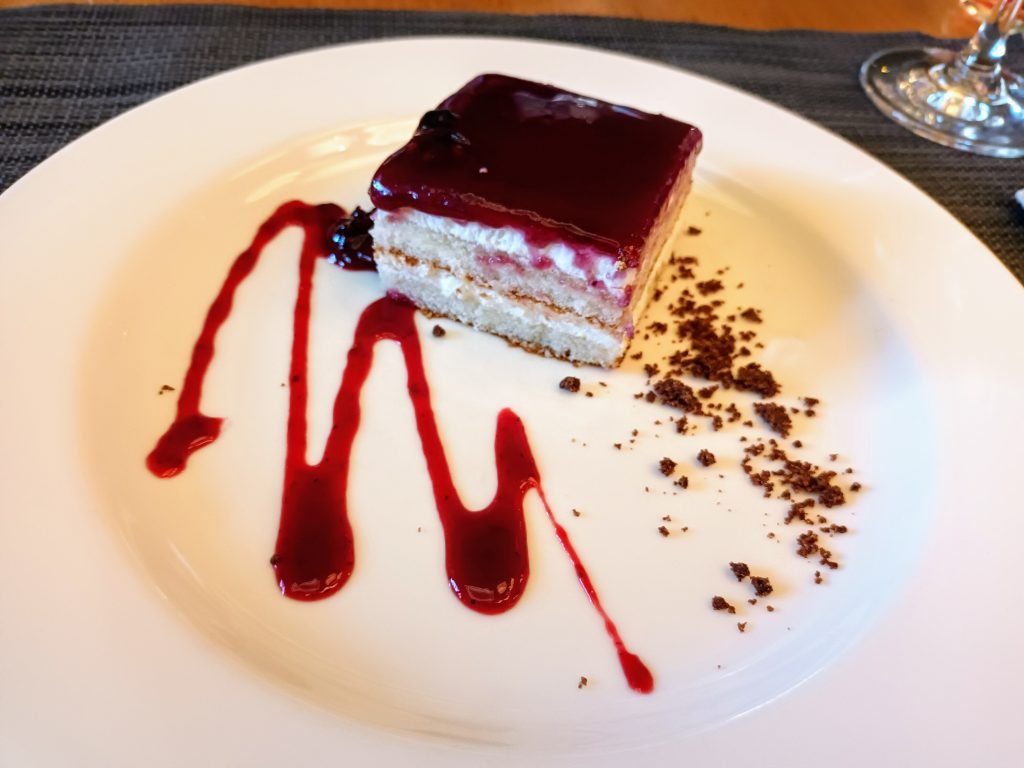

El Pou Clar
After we’d finished lunch, we piled back into the car for our next and final stop – the clear pools of El Pou Clar, a series of pools and springs which form the main water supply for the Clariano River.
Located in the Municipal Natural Park of the Sierra de l’Ombria in the municipality of Ontinyent, the pools of El Pou Clar are crystal clear, deep blue and surrounded by rocks and lush vegetation that make them a blissful place to relax.
Although Daniel said we could use his wetsuits if we wanted to have a swim, the time of year (November!) made the decision to enjoy a stroll instead a unanimous one.
Daniel told us that locals flock to the whole El Pou Clar in the summer months to have picnics, cliff-jump into the freezing waters and socialise with friends in the sun.
However, when we were there, we only encountered a couple of dog walkers, and I felt lucky to experience such a beautiful place without hordes of people around.
To be fair though, even in the crowded summer months, El Pou Clar is still one of those hidden gems around Valencia that has yet to be discovered by tourists.




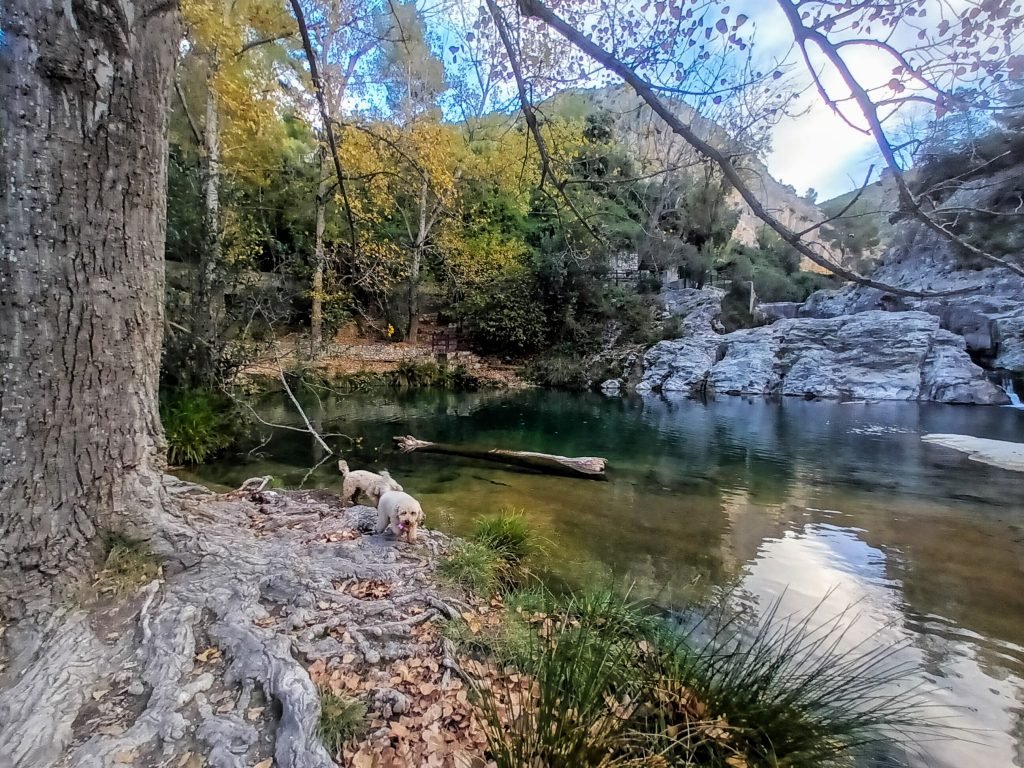
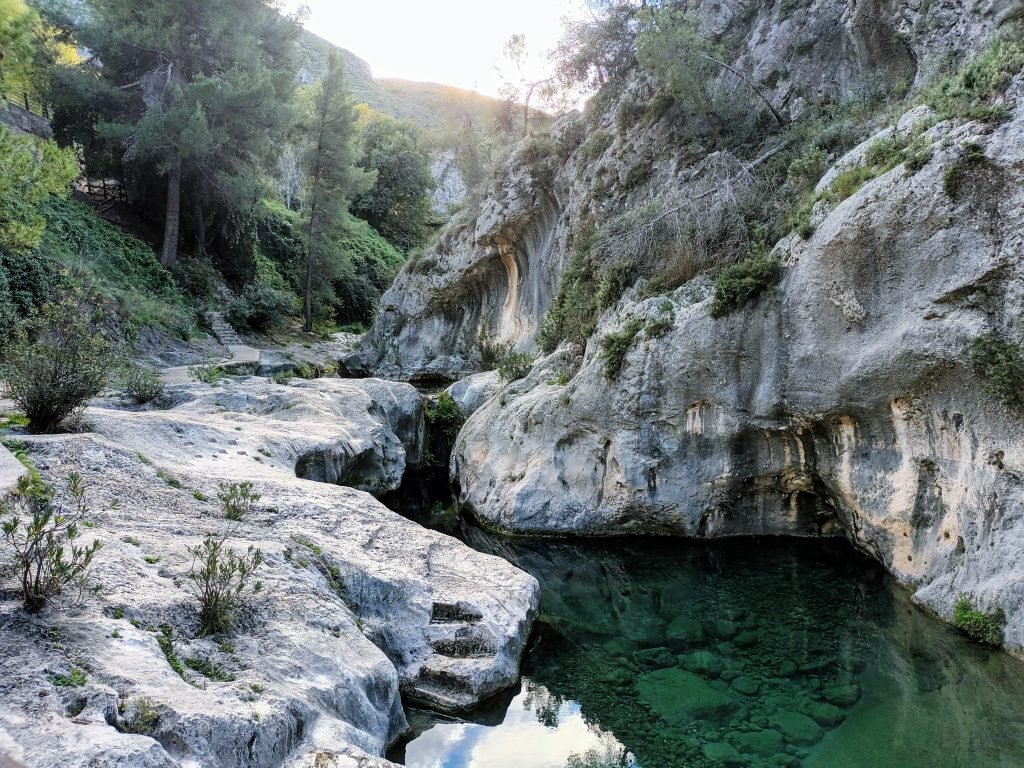
Visiting El Pou Clar & the Moorish Caves of Bocairent | Final Thoughts
When I visited the Chozas Carrascal winery in Utiel-Requena with Valtournative, I thought that it would be a difficult tour to beat.
However, I have to say that Bocairent and El Pou Clar absolutely blew me away and I haven’t stopped talking about my trip since I got back home!
From the enigmatic Moorish caves to the deep blue waters of El Pou Clar and the twisting, medieval streets of Bocairent, we enjoyed a truly magical day and I can’t recommend visiting this places enough.

In terms of visiting with a tour guide like Daniel vs. going alone, I have to say that I recommend the first option.
Not only do you need a car to reach these places, but the local knowledge and guidance by Daniel was priceless, and I don’t think I would have enjoyed exploring the area half as much without his stories of local myths, legends and historical facts.
The price of the tour that I attended was 87 EUR, not including lunch.
You can book yours here!
If you want to know more about my trip to Bocairent and El Pou Clar, please don’t hesitate to reach out and ask me in the comments section below. I respond to everybody and will be more than happy to help! 🙂
More Day Trips from Valencia
Teruel, Spain – The Forgotten Kingdom of Aragon
Albarracin, the Prettiest Village in Spain
Peniscola, the City in the Sea
Port Saplaya, the Little Venice of Valencia
El Palmar, Home of Paella
Utiel-Requena Wine Region
Montanejos Hot Springs
Oliva, a Charming Pueblo
Until next time,
XOXO
If you liked this article and would like to support my work, please click the button above to donate a couple of bucks and buy me a coffee. The ad revenue that I receive on this website is minimal, so support from my readers enables me to keep creating content that you (hopefully!) love to read.
Disclaimer: I attended this tour as a guest of Valtournative. Of course, all opinions are my own!


Hi I enjoyed your blog and have every intention of visiting however can you clarify the cost of the tour with a guide is that 87 euro per person ? if there are four of you that seems very expensive ?
Yes, the cost is per person, but you are paying for a full day with a professional tour guide and all transport (think fuel etc.). In my opinion, the cost is pretty standard for tours of this type!
I was lucky enough to be able to visit El Pou Clar this week, it was beautiful and in December very peaceful. I will definitely be on the lookout for a trip to Bocairent.